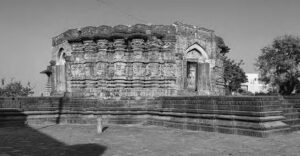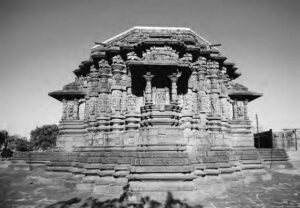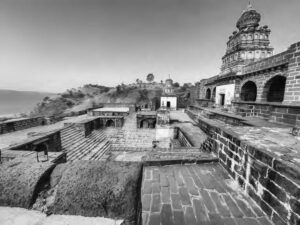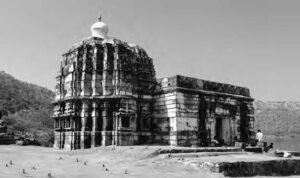Many places around the world celebrate unique geological formations or natural phenomena by associating them with divinity. In India, Lonar, one of the world’s largest terrestrial impact craters,
is considered a holy site and is the locus of several temples. It is one of the few hyper-velocity impact craters in basaltic rock. The natural history of the formation of the crater and the cultural history of how it has been perceived by humans can be seen at this site.
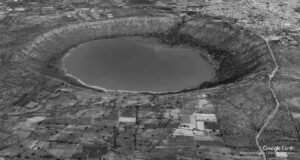
Lonar Crater: A Geological Marvel
Geological processes take extremely long, and the scale is often in tens of thousands or even millions of years. The Pleistocene Epoch was the geological age that lasted from about 2,580,000 to 11,700 years ago, and it was in this period that a meteorite collision impact created a large depression in the ground at Lonar. Situated in the Deccan plateau region of India, in the modern state of Maharashtra, Lonar has one of the very few and well-preserved terrestrial impact craters in the world. The site has been an important subject of study because the geomorphology and hydrology of
the crater are similar to other planetary bodies, especially Mars.1 Prior to the knowledge of the Lonar crater being the result of a meteorite impact, it was misunderstood as the outcome of a volcanic eruption ─ especially because the crater is in the volcanic basalt plateau. This perspective changed in the late twentieth century when studies proved the impact features and minerals were formed due to a meteor impact, and were not the result of a volcanic eruption.2
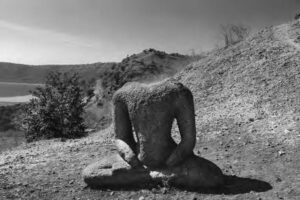
The Lonar crater has a mean diameter of 1.12 miles and the floor of the crater is filled with salt-water approximately 459 feet below the crater rim. Lonar Lake, locally known as the Lonar Sarovar, has a thin stretch of shore encircling it at water level. The main perennial feeder stream into the crater lake today is from the north-east, and is known as the Dhara (flow); about 50 meters (approx. 164 feet) lower is another perennial spring that drains into the lake, known as Sita Nahani (Sita’s bath, alluding to an episode from the Hindu epic Ramayana). Streams near the Papahareshvara temple and the Ramagaya temple are active only during the monsoon season or sometimes after the monsoons, if there is been substantial rainfall. Such saline and alkaline lakes are also called soda lakes, owing to the higher salinity and presence of biomass of halophilic archaea microbes, and support microorganisms like blue-green algae and bacteria. In the summer of 2020, the water in the lake had turned completely pink instead of its characteristic green color.3 Among the reasons suspected for this change in color was a tremendous increase in the salinity of the water during summer, minimal human intervention, and a limited water input from the feeder streams. This change of color not only intrigued scientists from all over the world but also attracted tourists to witness the dramatic sight. In the same year, Lonar Lake was recognized as a site of international importance, under the aegis of an inter-governmental treaty known as the Ramsar Convention. Founded in 1971 in the Iranian city of Ramsar, the convention currently involves the participation of over 170 countries, with a mission and pledge to preserve and promote wetlands. The convention is supported by several governmental agencies and private organizations.4
Since 2000, the Government of India has declared the forest surrounding Lonar Lake a wildlife sanctuary and is under the jurisdiction of the Maharashtra State Forest Department.
Archaeological Evidence at Lonar
At Lonar, material culture is extant in the form of temples, and can be dated from the tenth century onwards. The natural water sources and streams around the site, which feed the lake, are all understood as tirthas (places of crossing over), and are of particular importance in Hindu practice. All such locations are marked by a temple construction. These temples are clustered in three prime locations with respect to the crater. The first group is right at the fresh-water spring that flows along the rim and flows down into the crater. The second set of temples is below, on the shore of the salt-water lake, and the third cluster is in a human settlement on the rim of the crater. There is very little material evidence recovered from Lonar that can be dated prior to the building of these temples. On the periphery of Lonar town, sporadic early historical remains like potsherds, shell-bangles and areca-nut beads, datable to the Satavahana dynasty (200 BCE –200 CE), have been reported, but nothing significant and monumental is that early.5 Based on archaeological evidence, we can infer that Lonar gained importance as a religious site only after the tenth century. However, the crater was a well-known site prior to this period, and a small settlement was already present on the rim.
The highest concentration of temples at Lonar is in those that encircle the crater, thus making the crater central to all narratives associated with the temples. The most frequented temple site is the Dharatirtha, named after the perennial water spring that flows from here. The gully through which the water flows into the crater is also used as one of the main routes to access the lake. The architecture at Dharatirtha has undergone many changes through the centuries, evidence that it has been under continuous occupation. In addition to the main temple, are five small shrines dedicated to the Hindu deities Vishnu, Narasimha, Renuka, and Ganapati, built in different periods, and surrounded by semi-open spaces around the water tanks. The architecture of all these structures is simple, sparsely ornamented and utilitarian in design. As one descends towards the crater, large complexes like the Dharatirtha, with many temples at one place, become rarer, and single temples become common. The temples encircling the crater vary in size, architectural style, figural sculptures, and decorative patterns, and were built in different periods. For example, the Yajneshvara temple, midway on the descent to the crater, is a twelfth century monument, whereas the Ramagaya temple, similarly located on the eastern descent, is from the fifteenth century. Along the shores of the salt-water lake, the oldest temple is the Kamalaja Devi—a shrine dedicated to the goddess who is the family deity (kuladevi) of many people in the region. During the annual Hindu festival of Navaratri (during the months of October/November), a large fair is held here to celebrate and propitiate the goddess. The other temples along the shore of the salt-water lake are
not visited as frequently.
While circumventing the salt-water lake, one witnesses a historical timeline of at least four hundred years as evinced through its architecture. There is a strong physical connection between each temple and the crater. Successive temple-builders have not only honored the presence of the crater, but also added layers of meaning to the pilgrimage circuit, connecting all the places around and within the crater. The ashta tirtha yatra (pilgrimage of eight holy places) begins from the Dharatirtha and circumvents the crater covering all the temple locations. A reference to such a pilgrimage route is found in the early literature of the Mahanubhava sect, which gained prominence in the region during the twelfth and thirteenth centuries. The proponent of this sect, Chakradhara Svami, is said to have visited Lonar, when his disciple Bonebai undertook the ashta tirtha yatra of Lonar Sarovar. Lonar is also mentioned in the Lilacharitra and the Sthanapothi, both Mahanubhava texts written in the fourteenth or fifteenth century. It is clear that a pilgrimage to Lonar on astrologically auspicious occasions or simply to circumambulate the lake was a common practice in that period.

Making Myths: Religious Importance of Lonar
Beyond the ecological and geological significance of the crater, an important aspect of this landscape is the cultural perception. In India, most origins of rivers, their confluences, and mountains are often revered as sacred spaces; however, the site at Lonar has completely different features. It is not surprising that the lake is understood to represent divine power. Over time, an entire
mythological system has evolved, which explains the creation of the lake and its seasonal changes. The principal dominant myth is a story with two main characters: the god Vishnu in his manifestation as Daityasudana who triumphs over Lavanasura, the demon who was causing disruption of life in the region. Lonar Lake is explained as the outcome of this catastrophic event, where a divine power appeared to defeat the demon and restore righteousness.
The antiquity of Lonar is traced to the Kritayuga, a Hindu mythological golden age 2.16 million years before our present era, claimed through its purported textual reference in the Skanda Purana—a text that is part of the mythological corpus of early Hinduism.6 The Skanda Purana does mention a form of Vishnu, Daityasudana (associated with Lonar in other stories and texts and is the presiding deity in the prominent temples around the Lonar Lake), although there is no other direct reference to Lonar in the text. In another text, the Padma Purana, there is reference to a tank at Vishnu Gaya, which is revered for its sanctity. The text states that one who bathes in water from this tank is freed from all human bondage.7
Another mythological layer imposed on the landscape around the crater is the text known as the Lonar Mahatmya, an example of a sthala-mahatmya (local mythology), a genre that is specifically composed for a place. The Lonar Mahatmya, also known as the Virajakshetra Mahatmya, like other works of this type, is eulogistic in nature. The work appears to be written somewhere in the late eighteenth or early nineteenth century with the express purpose of emphasizing Lonar as a pilgrimage center. Two commonly expressed sculptural episodes of the Lonar myth (listed in detail
later in the essay) are expounded in eleven chapters of the Lonar Mahatmya with every minor physical feature in and around Lonar crater explained through stories in the text. In the nineteenth century, a holy man called Sachidashrama Svami settled at Lonar and is credited with rediscovery of the lost temple of Daityasudana along with the Lonar Mahatmya text. He ensured the popularity of Lonar as a place for piety, and ensured its relevance for pilgrimage routes.

It is said that the Lonar Mahatmya was narrated by the mythical sage Vyasa to Skanda—the son of Lord Shiva, also known as Kartikeya. The text claims it is a part of the Skanda Purana, although no revision of the Skanda Purana contains the text. The text begins with a brief introduction to the town of Lonar, also known as the Virajakshetra, situated about 100 miles from the River Godavari. Then the text introduces Lavanasura, the son of sage Kashyapa and his wife Diti, who had performed a severe penance to acquire a special boon from Lord Shiva: a favor that guaranteed
Lavanasura could not be killed by any of the gods, demons, semi-divine creatures, humans, animals, birds or by any natural calamities like earthquakes, lightning or thunder. Lavanasura was joyous to have received such a boon of immortality, when a voice from the sky prophesied that Lavanasura would be killed by an assault on his navel by a toddler. Outraged by this prophecy, Lavanasura began his search to find his nemesis, and first went to the Ocean. He alleged that the Ocean had provided shelter to the child who would eventually kill him. Enraged by this allegation, the Ocean cursed Lavanasura that after he was killed by the toddler, his body would disintegrate into salt. Having said this, the Ocean disappeared and Lavanasura resumed his journey to find his enemy. He then reached Amaravati, the abode of the king of gods Indra, and wanted his position, in order to make himself invincible. The two did fierce battle with Lavanasura taking over as the king of gods from the vanquished Indra. All the gods in heaven felt threatened, as Lavanasura began misbehaving and disrupting the cosmic order. Led by Brahma, they approached Vishnu and requested him to save heaven from the problematic demon. Vishnu assured them all that he would take the form of a toddler, defeat Lavanasura, and restore order to the world. The news that Vishnu would assume the form of a toddler to kill him reached Lavanasura, and therefore he decided to descend to the earth and live in a crater (here called as vivar) in the Sahyadri Mountains.
Meanwhile, Vishnu came to the earth in the avatara (material appearance) of a young Daityasudana and found his way to the den of Lavanasura, who was under the impression that he would easily be able to defeat a toddler. However, when Vishnu came forth as Daityasudana, Lavanasura’s clan and supporters deserted him. Daityasudana then used his foot to push the Lavanasura into the crater where he resided. Heavens resounded in celebrations following this victory. Lavansura repented his mistakes, rose from the ashes, sought atonement, and begged forgiveness from Daityasudana for all his misdeeds. He also requested Vishnu to reside in Lonar and thus make it Vishnu Gaya, a pious place where people would come to seek his blessings and be released from all kinds of bondage. As part of the atonement request to Daityasudana, Lavanasura requested that his body not go to waste, and he was therefore left behind in the crater. After this, the holy river Ganges in the form of Ganga Bhogavati began flowing from the Dhara valley to cleanse the blood of the demon off Vishnu.
Every physical aspect in the Lonar crater environs finds an explanation in this narrative. The name Lonar itself, is clearly derived from the demon Lavanasura who stayed in the place where the crater was created. ‘Lavana’ means salt in Sanskrit and the name Lonar originates from the root of the same word. An eleventh-century inscription refers to the place as Lonar, proving the name has been in use for at least a millennium. The demon’s body is supposed to have decomposed to form the salt-water lake, explaining the salinity and alkalinity of the lake. The fresh-water spring in
the north-eastern fringe of the crater is homologous to the holy Ganges river. Depictions of this myth are found in figural sculpture, particularly in the Daityasudana temple, which is the earliest evidence of this story represented as sculpture. It is probably the most famous and ornate of all the extant temples of Lonar and gets its name from the myth. Built in about the thirteenth century, one of the depictions of Daityasudana is in a narrative sculptural panel on a ceiling in this temple. Located in the vestibule between the sanctum and prayer hall, the panel shows a handsome Daityasudana at the center, crushing Lavanasura with his toe. Lavanasura’s sisters are on the right, pleading for their brother’s life, while a cow spouting the holy Ganges from her mouth is on the left. In India, it is quite rare to find the physical embodiment of a local myth associated with the creation of a place, at the place itself. The Daityasudana-Lavanasura story is derived from two popular narratives of Vishnu, the Vamana avatara and the Narasimha avatara. These two stories contain a common Hindu trope where Vishnu, as the ultimate savior of the world, appears in human form to vanquish troublesome demons to save the day.
The mythological narrative of Lonar, depicted through sculpture and literature, and reiterated through folk tales, encapsulates people’s perception and comprehension of the crater. It provides insights into the formation of the sacred geography of the Lonar crater. Beyond Hinduism, like many other multivalent sites in India, Lonar is also frequented by people practicing different religions. Several locations at the sites have different stories that resonate with multiple cults and faiths. Prominent among this is the connection between Lonar and the Mahanubhava sect that rose to prominence during the thirteenth century. The preceptor of this sect, Chakradhara Svami had visited Lonar during his pilgrimage and happened to meet the ruler of the Yadava dynasty, Kanharadeva (Krishnadeva). This is the only instance where Chakradhara Svami met anyone from the ruling Yadava polity. The sect regards pious all the locations where Chakradhara visited, sat, touched or resided. Therefore, around the site of Lonar, near the Dharatirtha, are several places that are sacred to the Mahanubhavas. The crater has a Muslim Sufi dargah (a shrine or tomb built over the grave of a revered figure) and is deemed sacred by its worshippers.
The Many Layers of Place-Making
The Lonar crater is a fine example of how geological phenomena are often overlaid with mythological meaning. The archaeological evidence allows us to construct a timeline for this human attempt at explaining and comprehending a landscape.
Geology is understood through natural materials and forms, while mythology is recovered through a literary study of stories and texts. Archaeological evidence comprises man-made artifacts physically recovered on the site. The identity of Lonar lies at the intersection of these three layers and the meaning assigned to its creation; thus transforming a mere geographical place to a cultural and religious space.
1. Goro Komatsu et al., “Drainage Systems of Lonar Crater, India: Contributions to Lonar Lake Hydrology and Crater Degradation,” Planetary and Space Science 95 (2014): 45–55.
2. R. F. Fudali et al., “Morphology of Lonar Crater, India: Comparisons and Implications,” The Moon and the Planets 23 (1980): 493–515.
3. Press Trust of India, “Why Did Lonar Lake Turn Pink? Experts Say ‘Haloarchaea’ Microbes Could be the Reason,” The Economic Times, last modified July 22, 2020, https://tinyurl.com/bde2r955.
4. “Funding Organizations,” Ramsar Convention on Wetlands, accessed July 12, 2022, https://tinyurl.com/4vx66hpz.
5. R. C. Agrawal, Archaeological Remains in Western India (Delhi, India: Agam Kala Prakashan, 1989).
6. Agrawal, 1989, 4.
7. Padma Purana, vol. VIII (Delhi, India: Motilal Banarasidass, 1954): verse 180.21–39, 2924.


